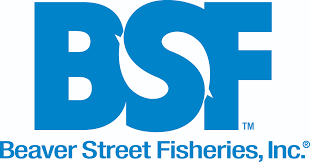After 75 years, Beaver Street Fisheries changes model (Courtesy of the Jacksonville Business Journal) — Bringing seafood to grocery shelves has become increasingly complex, particularly in the wake of the Covid-19 pandemic. For Beaver Street Fisheries, a Jacksonville-based seafood distributor, the combination of the pandemic, international conflicts and tariffs has dramatically reshaped their operations.
The company has experienced volatile pricing, with the cost of a shipping container soaring from $2,000 pre-pandemic to a peak of $18,000 during the height of the crisis, now settling around $8,000.
Logistics timelines have also lengthened significantly.
What once took four to six weeks can now extend to as long as 16 weeks, according to Lloyd Carter, Beaver Street Fisheries’ director of operations.
Disruptions that have affected overseas carriers for Beaver Street Fisheries have ranged from the closing of the Suez Canal to war in the Middle East.
“You go have a war in the Middle East, and they close the Suez Canal, and now they’re going all the way around, you add two, three weeks in your transit. That’s inventory,” Beaver Street Fisheries Chief Information Officer Scott Lane said. “That’s our inventory that we bought. And now I got three more weeks of inventory in the water. So you just start looking at all these costs. How much does it cost to get something from the middle of Asia to Jacksonville? Well, it goes up. The delays and the unpredictability, that’s what we’re seeing.”
Adapting to a volatile freight environment with new technology
After four years of Covid, the company is still charting its way through new waters.
“Everyone said, ‘Oh, Covid’s over, and the supply chain is going to go back to this back-to-normal pre-Covid.’ (It) never happened, and world events keep changing so dramatically that it almost can’t. This is the new normal,” Lane said.
Lane oversees implementation of technology for Beaver Street Fisheries.
The challenges Beaver Street Fisheries faces are similar to those of many companies transporting cargo overseas. Adapting to the volatile overseas freight environment has entailed moving operations, with some companies moving manufacturing from China to India to steer clear of tariffs and others exploring nearshoring with countries closer to the U.S.
The same cannot be as easily done for seafood. Relocation doesn’t suit mother nature.
“If someone said, the United States has figured out the best way to grow and harvest grain, we’re the world’s best at doing that because we got really good at it,” Lane said. “Thailand got really good at growing shrimp. So you can’t just pick that up and nearshore (it) … you got to go develop that overarching skill set … the whole ecosystem’s got to go. So it can’t, it doesn’t move. These countries have developed this over years and got really, really good at what they do.”
What Beaver Street Fisheries has changed is the technology it’s invested in. In particular, the company has started using Shipwell, a newer transportation management system that has been key in tracking cargo and also solving problems carriers may encounter overseas.
“… We wanted something that was a little bit more robust, something that could give us a little bit more detail, that could spell out exactly where a carrier or a load was located as we move it through the supply chain and toward the customer,” Carter said. “Let’s just say, example being, if we got a challenge with a load, we can actually tender that load. Tender that load to a carrier partner.”
The process to tender the load is now done in an internal system with a set of carrier partners.
“So everybody’s working in a system, and it’s like intra, as opposed to internet, and the response time is a little bit, it’s much better, I should say,” Carter said. “And less errors, less challenges, as far as getting the loads to the customer, because we’re moving much faster than we did in previous years.”
With an abundance of potential delays for cargo, companies like Beaver Street Fisheries have to manage the supply chain in a way they didn’t have to before.
What Beaver Street Fisheries has done with Shipwell is begin to integrate what used to be two disparate systems.
“When we went from our old system to the new one, instead of just looking at it as, oh, look, we can do our domestic outbound transportation, which is what we’ve traditionally done, that software actually does the inbound side and says, ‘Oh, you want to track a container on a vessel in the middle of the ocean? We can do that,’ ” Lane said.
Shifting to retail
On the domestic side, Beaver Street Fisheries is in a much-altered landscape of who its customers are.
As the pandemic shut down the restaurant industry for months in 2020, Beaver Street Fisheries diverged the majority of its business to retail.
And the business with restaurants hasn’t gone back to where it used to be. Pre-pandemic, Beaver Street Fisheries was making 50% of shipments to retail and half to restaurants.
Even as food service and restaurant business slowly recovered, retail remained king. About 70% of its shipments currently are being made to retail.
“Food Service probably caught up to where it used to be, but our retail footprint changed drastically, which for any business, that changes, because retail has different requirements than food service,” Lane said.
This prompted an expansion of Beaver Street Fisheries’ manufacturing resources. The local seafood distributor has added more space for production, increasing manufacturing space from 20,000 square feet to 30,000 square feet.
For manufacturing, producing packaging in-house at the Jacksonville facilities became an essential asset for expanding into retail.
“Chefs don’t worry about a nice bag with artwork. They just go, I need this spec of fish,” Lane said. “Whereas you as a consumer, when you walk in the store, you expect a bag with artwork … So when our business shifted, so did we. So when we had to go and expand our manufacturing, that was to keep up with that retail ask, it wasn’t the food service side that drove it, it was the retail side that drove it.”
The packaging Beaver Street Fisheries creates includes individual vacuum pack pouches, skin pack for rigid trays and thermoform skin pack.
Lane said that retailers are also turning to them for more tailored customization of packaging.
“One of the things that we (did) when we did that expansion on the retail side is private label, so you got these grocers now asking us like, ‘Hey, can you pack this in my label?’ ” Lane said. “So salmon is salmon, right? But you got to put it in a green bag or a red bag or a blue bag … If it meets their specs then we do whatever it is, and so we’ll either size it, so we will do that kind of customization.”
The Future
Beaver Street Fisheries has faced challenges just as any other company moving cargo across the world.
After four years of Covid, geopolitical issues like the war in the Middle East and Suez Canal have raised costs and caused additional disruptions in shipping.
As it’s not easy to relocate the source of seafood, navigating through these challenges all comes down to endurance.
“The cost is the cost. It’s going to increase, and you just sort of got to endure that … things are going to go up and things are going to come down during covid. Container (prices were) as high as $18,000 just to get it over here, and then it dropped to all time lows, and now it’s starting to swing up again,” Carter said. “… that’s just par for the course with the supply chain.”

